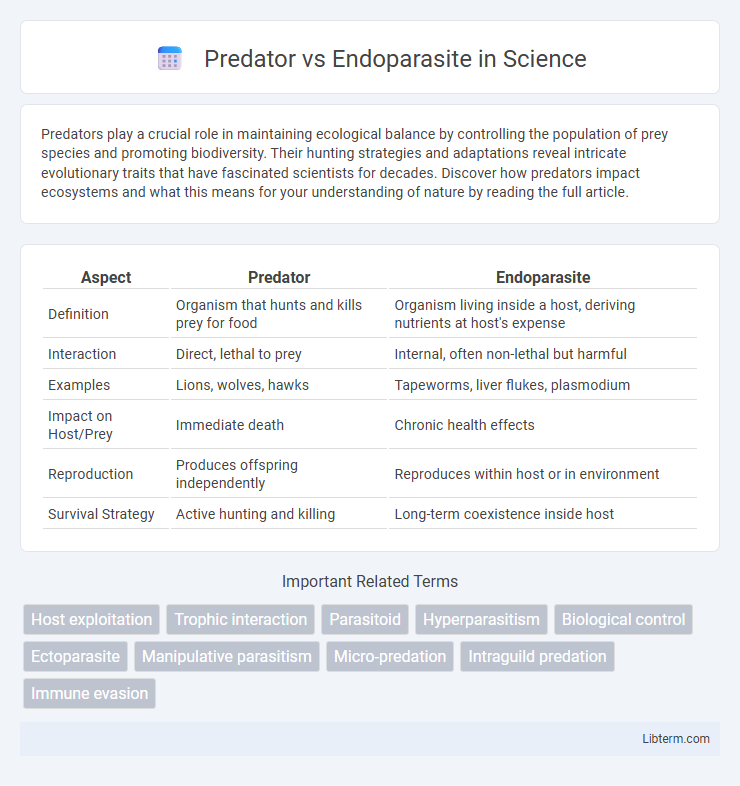Predators play a crucial role in maintaining ecological balance by controlling the population of prey species and promoting biodiversity. Their hunting strategies and adaptations reveal intricate evolutionary traits that have fascinated scientists for decades. Discover how predators impact ecosystems and what this means for your understanding of nature by reading the full article.
Table of Comparison
| Aspect | Predator | Endoparasite |
|---|---|---|
| Definition | Organism that hunts and kills prey for food | Organism living inside a host, deriving nutrients at host's expense |
| Interaction | Direct, lethal to prey | Internal, often non-lethal but harmful |
| Examples | Lions, wolves, hawks | Tapeworms, liver flukes, plasmodium |
| Impact on Host/Prey | Immediate death | Chronic health effects |
| Reproduction | Produces offspring independently | Reproduces within host or in environment |
| Survival Strategy | Active hunting and killing | Long-term coexistence inside host |
Introduction to Predators and Endoparasites
Predators actively hunt and kill other organisms, playing a crucial role in controlling prey populations and maintaining ecological balance. Endoparasites live inside their hosts, extracting nutrients over an extended period without immediate lethality, often causing chronic health effects. Both predators and endoparasites significantly influence ecosystem dynamics through their distinct interactions with prey and hosts.
Defining Predators: Strategies and Adaptations
Predators are organisms that actively hunt and kill other organisms for food, utilizing strategies such as camouflage, speed, and specialized sensory organs to enhance hunting efficiency. Adaptations like sharp teeth, claws, venom, and ambush tactics enable predators to capture and subdue prey effectively. These evolutionary traits optimize their role as top consumers in ecosystems, driving natural selection and maintaining population balance.
Understanding Endoparasites: Life Cycles and Hosts
Endoparasites exhibit complex life cycles involving multiple hosts, often requiring an intermediate host to complete development before infecting a primary host. Their survival depends on intricate adaptations that facilitate entry, evasion of immune responses, and nutrient absorption within the host's body. Understanding these life cycles aids in controlling parasitic diseases and mitigating their impact on ecosystems and agriculture.
Ecological Roles of Predators vs Endoparasites
Predators regulate prey populations by directly consuming multiple individuals, thereby maintaining ecosystem balance and promoting biodiversity. Endoparasites influence host population dynamics more subtly by reducing host fitness and reproduction without immediate lethal effects, often driving long-term evolutionary adaptations. Together, these ecological roles shape community structure and energy flow, highlighting distinct mechanisms of population control and species interactions.
Modes of Interaction with Prey or Host
Predators actively hunt and kill their prey to consume them immediately, often employing strategies such as stalking, ambushing, or chasing. Endoparasites live inside their hosts and extract nutrients over an extended period without killing the host outright, relying on stealthy invasion and immune evasion mechanisms. Predatory interaction results in rapid prey death, whereas endoparasitic relationships typically involve long-term host exploitation and manipulation.
Impact on Population Dynamics
Predators regulate prey populations by reducing their numbers through consumption, often triggering population cycles and maintaining ecological balance. Endoparasites decrease host fitness by extracting resources and causing diseases, which can lead to chronic declines in host population density and increased mortality rates. Both interactions influence population dynamics but predators tend to cause immediate population reductions, whereas endoparasites exert longer-term, subtle effects on host survival and reproduction.
Evolutionary Arms Race: Adaptation and Counter-Adaptation
Predator and endoparasite interactions drive an evolutionary arms race where predators evolve enhanced hunting strategies while endoparasites develop sophisticated mechanisms to evade immune responses within hosts. Adaptations such as improved sensory systems in predators and molecular mimicry in endoparasites exemplify reciprocal selective pressures shaping survival. This continuous cycle of adaptation and counter-adaptation leads to increased specialization and coevolutionary complexity between both biological antagonists.
Health and Disease Implications
Predators control prey populations, reducing the spread of vector-borne diseases by limiting host availability, while endoparasites directly impact host health through nutrient depletion and tissue damage. Predation can indirectly influence disease dynamics by altering host behavior and density, whereas endoparasitic infections increase susceptibility to secondary infections and weaken immune responses. Understanding the balance between predation and parasitism is crucial for managing wildlife health and mitigating zoonotic disease risks in ecosystems.
Examples of Predatory and Endoparasitic Species
Predatory species such as lions (Panthera leo), wolves (Canis lupus), and great white sharks (Carcharodon carcharias) actively hunt and kill their prey for food. Endoparasitic species include tapeworms (class Cestoda), which inhabit the intestines of vertebrates, and Plasmodium spp., the protozoan parasites responsible for malaria within human red blood cells. These distinct survival strategies highlight the varied adaptations in the animal kingdom, where predators rely on overt hunting while endoparasites depend on prolonged host exploitation.
Conclusion: Comparing Their Ecological Significance
Predators regulate prey populations by reducing density and promoting biodiversity through selective feeding, which shapes community dynamics and ecosystem balance. Endoparasites influence host population health by affecting reproduction and survival rates, often driving coevolutionary processes and maintaining ecological stability. Both predators and endoparasites are critical for ecosystem function, with predators exerting top-down control and endoparasites contributing to host population regulation and nutrient cycling.
Predator Infographic

 libterm.com
libterm.com